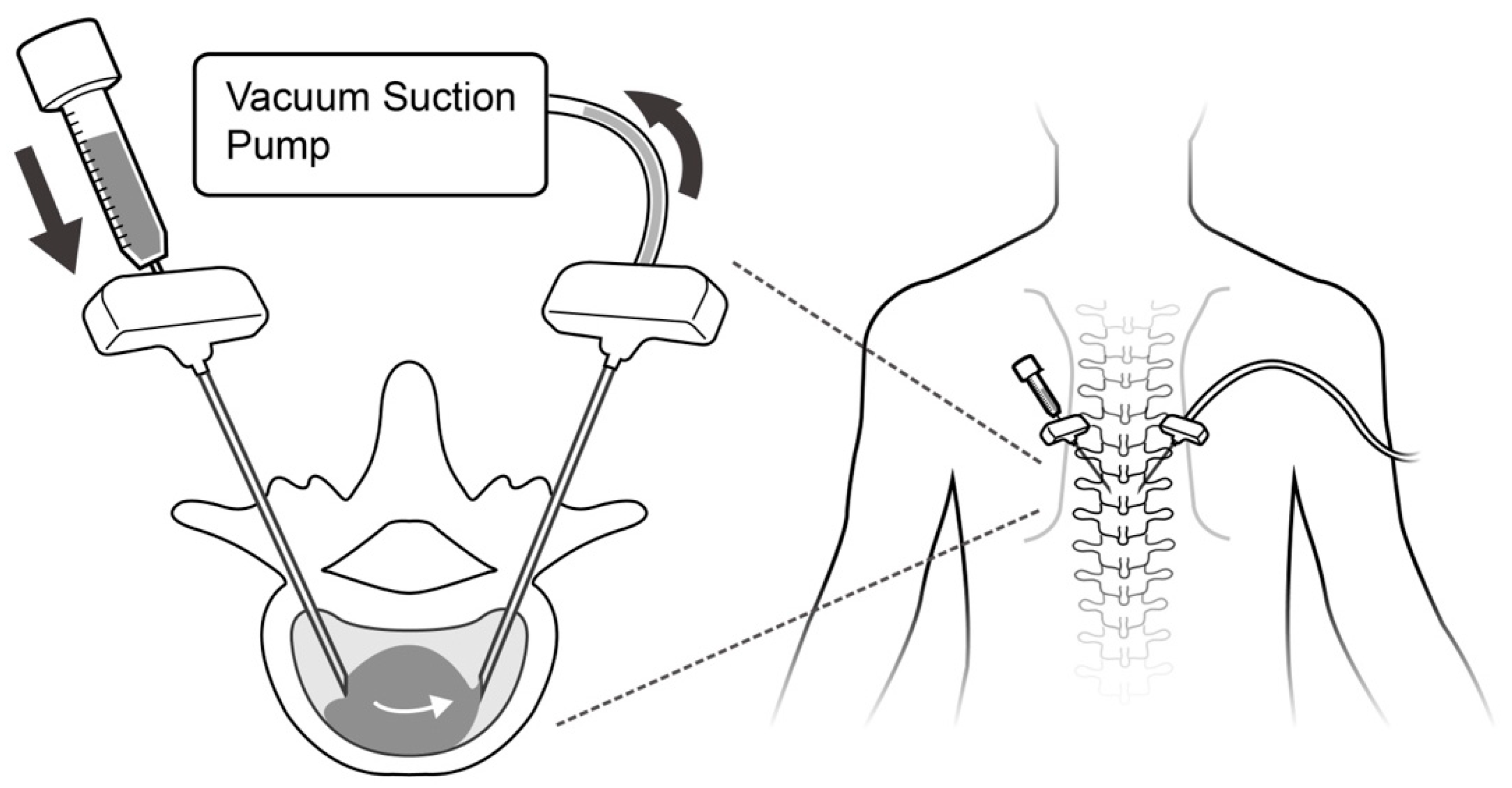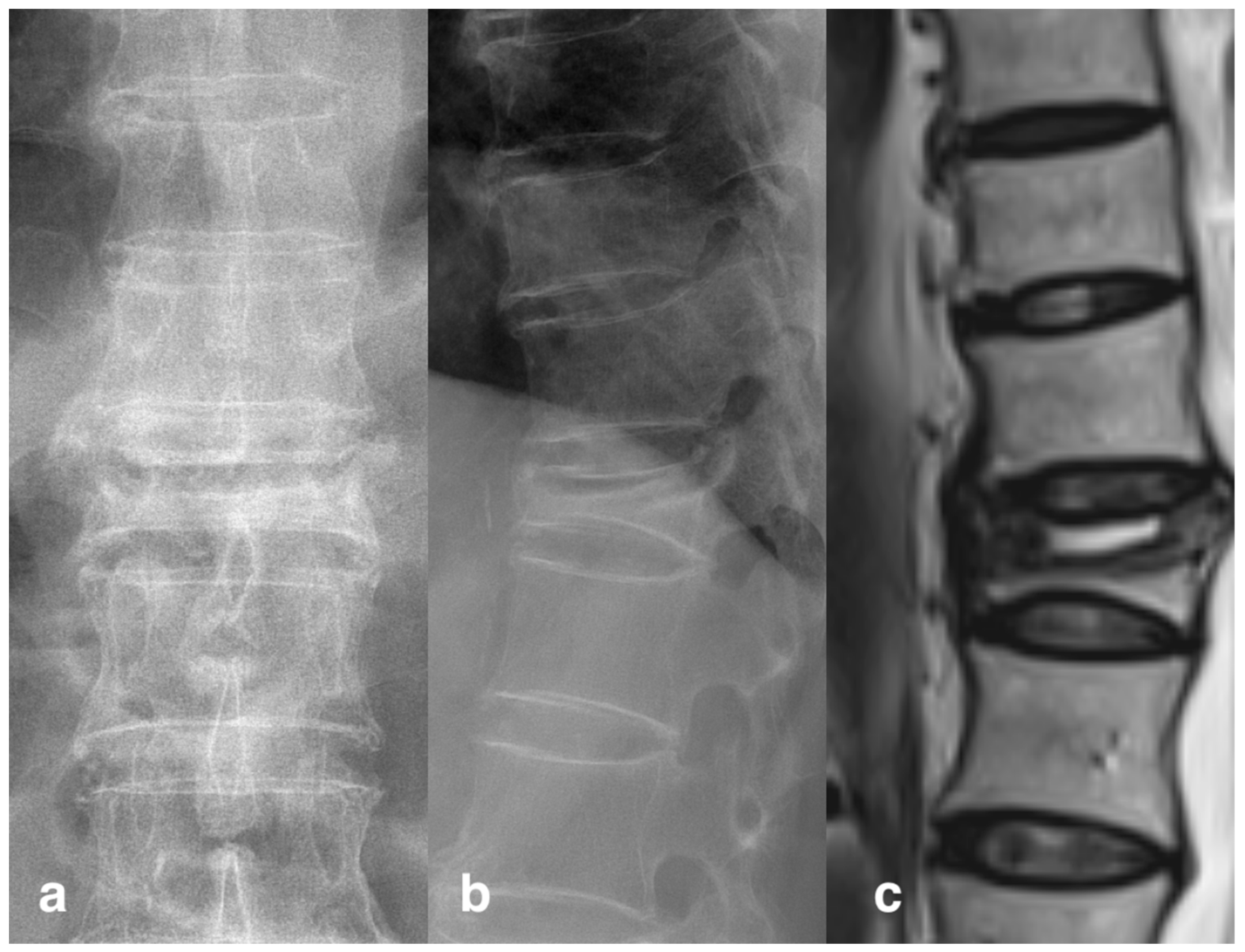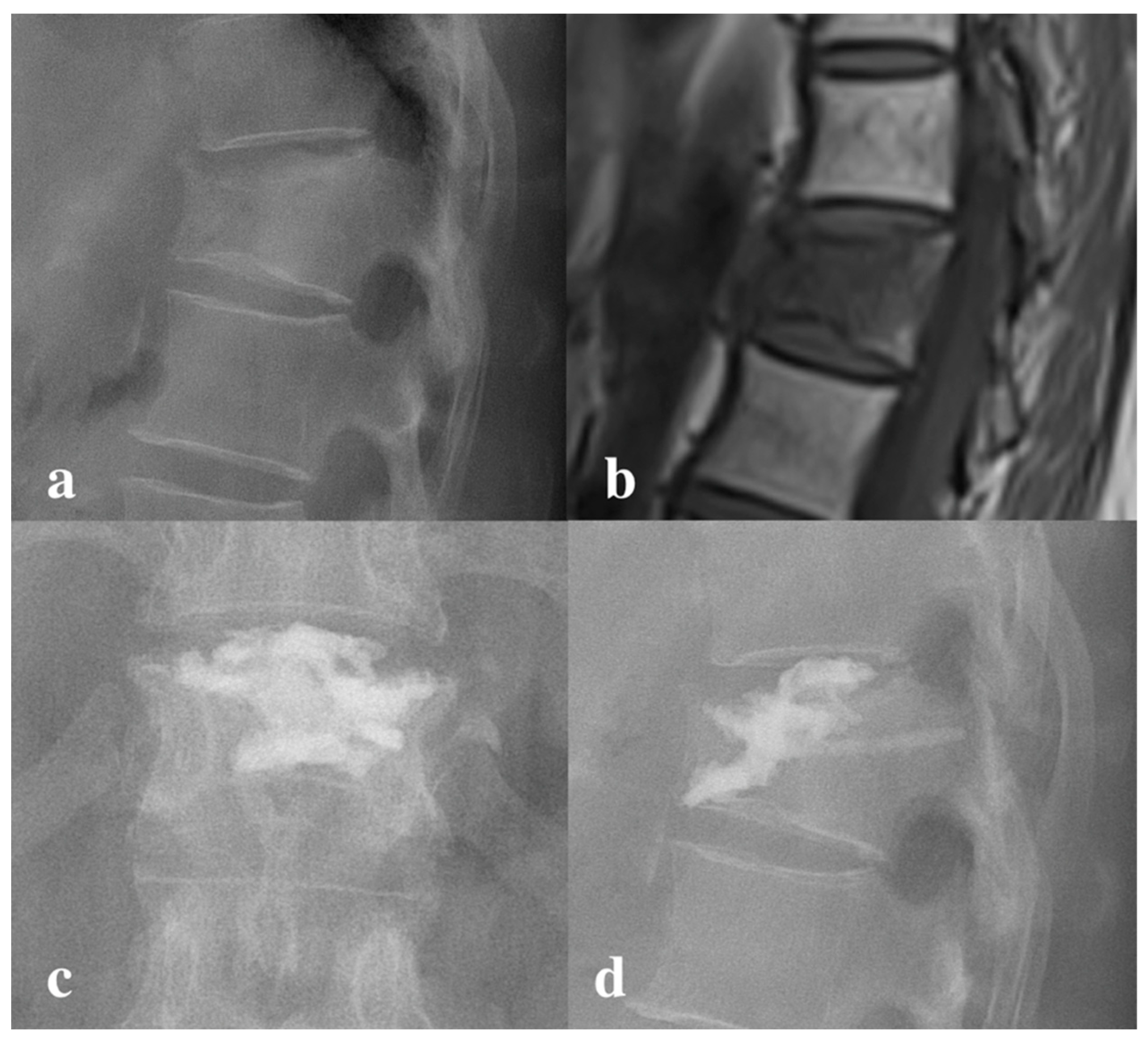Assessment of Cement Leakage in Decompressed Percutaneous Kyphoplasty
Abstract
1. Introduction
2. Materials and Methods
2.1. Study Design
2.2. Patient Inclusion Criteria
2.3. Exclusion Criteria
2.4. Surgical Technique
2.4.1. Decompressed Kyphoplasty
2.4.2. Vertebroplasty with High Viscosity Cement
2.4.3. Post-Operative Care
2.5. Radiographic Results
2.6. Statistics Analysis
3. Results
3.1. Patient Demographics
3.2. Radiography Results
3.3. Complications
4. Discussion
5. Conclusions
Author Contributions
Funding
Institutional Review Board Statement
Informed Consent Statement
Data Availability Statement
Conflicts of Interest
References
- Silverman, S.L. The clinical consequences of vertebral compression fracture. Bone 1992, 13 (Suppl. S2), S27–S31. [Google Scholar] [CrossRef] [PubMed]
- Kim, D.H.; Vaccaro, A.R. Osteoporotic compression fractures of the spine; current options and considerations for treatment. Spine J. 2006, 6, 479–487. [Google Scholar] [CrossRef] [PubMed]
- Cooper, C.; O’Neill, T.; Silman, A. The epidemiology of vertebral fractures. European Vertebral Osteoporosis Study Group. Bone 1993, 14 (Suppl. S1), S89–S97. [Google Scholar] [CrossRef] [PubMed]
- Tezer, M.; Erturer, R.E.; Ozturk, C.; Ozturk, I.; Kuzgun, U. Conservative treatment of fractures of the thoracolumbar spine. Int. Orthop. 2005, 29, 78–82. [Google Scholar] [CrossRef]
- Lee, H.M.; Park, S.Y.; Lee, S.H.; Suh, S.W.; Hong, J.Y. Comparative analysis of clinical outcomes in patients with osteoporotic vertebral compression fractures (OVCFs): Conservative treatment versus balloon kyphoplasty. Spine J. 2012, 12, 998–1005. [Google Scholar] [CrossRef] [PubMed]
- Barr, J.D.; Barr, M.S.; Lemley, T.J.; McCann, R.M. Percutaneous vertebroplasty for pain relief and spinal stabilization. Spine 2000, 25, 923–928. [Google Scholar] [CrossRef]
- Martin, J.B.; Jean, B.; Sugiu, K.; San Millan Ruiz, D.; Piotin, M.; Murphy, K.; Rufenacht, B.; Muster, M.; Rufenacht, D.A. Vertebroplasty: Clinical experience and follow-up results. Bone 1999, 25, 11S–15S. [Google Scholar] [CrossRef]
- Hulme, P.A.; Krebs, J.; Ferguson, S.J.; Berlemann, U. Vertebroplasty and kyphoplasty: A systematic review of 69 clinical studies. Spine 2006, 31, 1983–2001. [Google Scholar] [CrossRef]
- Kuo, Y.R.; Cheng, T.A.; Chou, P.H.; Liu, Y.F.; Chang, C.J.; Chuang, C.F.; Su, P.F.; Lin, R.M.; Lin, C.L. Healing of Vertebral Compression Fractures in the Elderly after Percutaneous Vertebroplasty—An Analysis of New Bone Formation and Sagittal Alignment in a 3-Year Follow-Up. J. Clin. Med. 2022, 11, 708. [Google Scholar] [CrossRef]
- Schmidt, R.; Cakir, B.; Mattes, T.; Wegener, M.; Puhl, W.; Richter, M. Cement leakage during vertebroplasty: An underestimated problem? Eur. Spine J. 2005, 14, 466–473. [Google Scholar] [CrossRef]
- Ding, J.; Zhang, Q.; Zhu, J.; Tao, W.; Wu, Q.; Chen, L.; Shi, P.; Zhang, H. Risk factors for predicting cement leakage following percutaneous vertebroplasty for osteoporotic vertebral compression fractures. Eur. Spine J. 2016, 25, 3411–3417. [Google Scholar] [CrossRef] [PubMed]
- Nussbaum, D.A.; Gailloud, P.; Murphy, K. A review of complications associated with vertebroplasty and kyphoplasty as reported to the Food and Drug Administration medical device related web site. J. Vasc. Interv. Radiol. 2004, 15, 1185–1192. [Google Scholar] [CrossRef] [PubMed]
- Nakano, M.; Hirano, N.; Ishihara, H.; Kawaguchi, Y.; Matsuura, K. Calcium phosphate cement leakage after percutaneous vertebroplasty for osteoporotic vertebral fractures: Risk factor analysis for cement leakage. J. Neurosurg. Spine 2005, 2, 27–33. [Google Scholar] [CrossRef] [PubMed]
- Nieuwenhuijse, M.J.; Van Erkel, A.R.; Dijkstra, P.D. Cement leakage in percutaneous vertebroplasty for osteoporotic vertebral compression fractures: Identification of risk factors. Spine J. 2011, 11, 839–848. [Google Scholar] [CrossRef] [PubMed]
- Yeom, J.S.; Kim, W.J.; Choy, W.S.; Lee, C.K.; Chang, B.S.; Kang, J.W. Leakage of cement in percutaneous transpedicular vertebroplasty for painful osteoporotic compression fractures. J. Bone Joint Surg. Br. 2003, 85, 83–89. [Google Scholar] [CrossRef]
- Li, M.; Zhang, T.; Zhang, R.; Zhang, H.; Zhang, D.; Hu, N.; Wang, Y. Systematic Retrospective Analysis of Risk Factors and Preventive Measures of Bone Cement Leakage in Percutaneous Kyphoplasty. World. Neurosurg. 2023, 171, e828–e836. [Google Scholar] [CrossRef]
- Baroud, G.; Crookshank, M.; Bohner, M. High-viscosity cement significantly enhances uniformity of cement filling in vertebroplasty: An experimental model and study on cement leakage. Spine 2006, 31, 2562–2568. [Google Scholar] [CrossRef]
- Zhang, L.; Wang, J.; Feng, X.; Tao, Y.; Yang, J.; Wang, Y.; Zhang, S.; Cai, J.; Huang, J. A comparison of high viscosity bone cement and low viscosity bone cement vertebroplasty for severe osteoporotic vertebral compression fractures. Clin. Neurol. Neurosurg. 2015, 129, 10–16. [Google Scholar] [CrossRef]
- Wang, C.H.; Ma, J.Z.; Zhang, C.C.; Nie, L. Comparison of high-viscosity cement vertebroplasty and balloon kyphoplasty for the treatment of osteoporotic vertebral compression fractures. Pain. Physician. 2015, 18, E187–E194. [Google Scholar]
- Li, K.; Ji, C.; Luo, D.; Zhang, W.; Feng, H.; Yang, K.; Xu, H. Role of percutaneous vertebroplasty with high-viscosity cement in the treatment of severe osteoporotic vertebral compression fractures. Sci. Rep. 2021, 11, 4602. [Google Scholar] [CrossRef]
- Reading, A.D.; McCaskie, A.W.; Barnes, M.R.; Gregg, P.J. A comparison of 2 modern femoral cementing techniques: Analysis by cement-bone interface pressure measurements, computerized image analysis, and static mechanical testing. J. Arthroplasty 2000, 15, 479–487. [Google Scholar] [CrossRef] [PubMed]
- Rey, R.M., Jr.; Paiement, G.D.; McGann, W.M.; Jasty, M.; Harrigan, T.P.; Burke, D.W.; Harris, W.H. A study of intrusion characteristics of low viscosity cement Simplex-P and Palacos cements in a bovine cancellous bone model. Clin. Orthop. Relat. Res. 1987, 215, 272–278. [Google Scholar] [CrossRef]
- Tschirhart, C.E.; Roth, S.E.; Whyne, C.M. Biomechanical assessment of stability in the metastatic spine following percutaneous vertebroplasty: Effects of cement distribution patterns and volume. J. Biomech. 2005, 38, 1582–1590. [Google Scholar] [CrossRef]
- Liang, D.; Ye, L.Q.; Jiang, X.B.; Yang, P.; Zhou, G.Q.; Yao, Z.S.; Zhang, S.C.; Yang, Z.D. Biomechanical effects of cement distribution in the fractured area on osteoporotic vertebral compression fractures: A three-dimensional finite element analysis. J. Surg. Res. 2015, 195, 246–256. [Google Scholar] [CrossRef]
- Chen, B.; Li, Y.; Xie, D.; Yang, X.; Zheng, Z. Comparison of unipedicular and bipedicular kyphoplasty on the stiffness and biomechanical balance of compression fractured vertebrae. Eur. Spine J. 2011, 20, 1272–1280. [Google Scholar] [CrossRef]
- Li, Y.D.; Tsai, T.T.; Niu, C.C.; Lai, P.L. Cement bridging phenomenon in percutaneous vertebroplasty for adjacent vertebral compression fracture. Sci. Rep. 2021, 11, 10184. [Google Scholar] [CrossRef]
- Chu, W.; Tsuei, Y.C.; Liao, P.H.; Lin, J.H.; Chou, W.H.; Chu, W.C.; Young, S.T. Decompressed percutaneous vertebroplasty: A secured bone cement delivery procedure for vertebral augmentation in osteoporotic compression fractures. Injury 2013, 44, 813–818. [Google Scholar] [CrossRef]
- Lu, H.T.; Lin, J.Y.; Tsuei, Y.C.; Hsu, Y.F.; Chen, C.Y.; Cheng, S.H.; Chu, W.; Li, C.; Chu, W.C. Impact of Aspiration Percutaneous Vertebroplasty in Reducing Bone Cement Leakage and Enhancing Distribution-An Ex Vivo Study in Goat Vertebrae. Bioengineering 2023, 10, 795. [Google Scholar] [CrossRef]
- Theodorou, D.J. The intravertebral vacuum cleft sign. Radiology. 2001, 221, 787–788. [Google Scholar] [CrossRef]
- Lavelle, W.; Carl, A.; Lavelle, E.D.; Khaleel, M.A. Vertebroplasty and kyphoplasty. Anesthesiol. Clin. 2007, 25, 913–928. [Google Scholar] [CrossRef]
- Georgy, B.A. Clinical experience with high-viscosity cements for percutaneous vertebral body augmentation: Occurrence, degree, and location of cement leakage compared with kyphoplasty. AJNR. Am. J. Neuroradiol. 2010, 31, 504–508. [Google Scholar] [CrossRef]
- Bohner, M.; Gasser, B.; Baroud, G.; Heini, P. Theoretical and experimental model to describe the injection of a polymethylmethacrylate cement into a porous structure. Biomaterials 2003, 24, 2721–2730. [Google Scholar] [CrossRef]
- Hong, S.J.; Lee, S.; Yoon, J.S.; Kim, J.H.; Park, Y.K. Analysis of intradiscal cement leakage during percutaneous vertebroplasty: Multivariate study of risk factors emphasizing preoperative MR findings. J. Neuroradiol. 2014, 41, 195–201. [Google Scholar] [CrossRef]
- Bean, D.J.; Hollis, J.M.; Woo, S.L.; Convery, F.R. Sustained pressurization of polymethylmethacrylate: A comparison of low- and moderate-viscosity bone cements. J. Orthop. Res. 1988, 6, 580–584. [Google Scholar] [CrossRef]
- Qi, J.; Hu, Y.; Yang, Z.; Dong, Y.; Zhang, X.; Hou, G.; Lv, Y.; Guo, Y.; Zhou, F.; Liu, B.; et al. Incidence, Risk Factors, and Outcomes of Symptomatic Bone Cement Displacement following Percutaneous Kyphoplasty for Osteoporotic Vertebral Compression Fracture: A Single Center Study. J. Clin. Med. 2022, 11, 7530. [Google Scholar] [CrossRef]
- Libicher, M.; Appelt, A.; Berger, I.; Baier, M.; Meeder, P.J.; Grafe, I.; Dafonseca, K.; Noldge, G.; Kasperk, C. The intravertebral vacuum phenomen as specific sign of osteonecrosis in vertebral compression fractures: Results from a radiological and histological study. Eur. Radiol. 2007, 17, 2248–2252. [Google Scholar] [CrossRef]
- Chin, D.K.; Kim, Y.S.; Cho, Y.E.; Shin, J.J. Efficacy of postural reduction in osteoporotic vertebral compression fractures followed by percutaneous vertebroplasty. Neurosurgery 2006, 58, 695–700, discussion 695–700. [Google Scholar] [CrossRef]
- Tanigawa, N.; Kariya, S.; Komemushi, A.; Tokuda, T.; Nakatani, M.; Yagi, R.; Sawada, S. Cement leakage in percutaneous vertebroplasty for osteoporotic compression fractures with or without intravertebral clefts. AJR. Am. J. Roentgenol. 2009, 193, W442–W445. [Google Scholar] [CrossRef]
- Jung, J.Y.; Lee, M.H.; Ahn, J.M. Leakage of polymethylmethacrylate in percutaneous vertebroplasty: Comparison of osteoporotic vertebral compression fractures with and without an intravertebral vacuum cleft. J. Comput. Assist. Tomogr. 2006, 30, 501–506. [Google Scholar] [CrossRef]
- Krauss, M.; Hirschfelder, H.; Tomandl, B.; Lichti, G.; Bar, I. Kyphosis reduction and the rate of cement leaks after vertebroplasty of intravertebral clefts. Eur. Radiol. 2006, 16, 1015–1021. [Google Scholar] [CrossRef]
- Hiwatashi, A.; Ohgiya, Y.; Kakimoto, N.; Westesson, P.L. Cement leakage during vertebroplasty can be predicted on preoperative MRI. AJR. Am. J. Roentgenol. 2007, 188, 1089–1093. [Google Scholar] [CrossRef] [PubMed]
- Ha, K.Y.; Lee, J.S.; Kim, K.W.; Chon, J.S. Percutaneous vertebroplasty for vertebral compression fractures with and without intravertebral clefts. J. Bone. Joint Surg. Br. 2006, 88, 629–633. [Google Scholar] [CrossRef]
- Zhan, Y.; Jiang, J.; Liao, H.; Tan, H.; Yang, K. Risk Factors for Cement Leakage after Vertebroplasty or Kyphoplasty: A Meta-Analysis of Published Evidence. World Neurosurg. 2017, 101, 633–642. [Google Scholar] [CrossRef] [PubMed]
- Varga, P.P.; Jakab, G.; Bors, I.B.; Lazary, A.; Szoverfi, Z. Experiences with PMMA cement as a stand-alone intervertebral spacer. Percutaneous cement discoplasty in the case of vacuum phenomenon within lumbar intervertebral discs. Orthopade 2015, 44, 124–131. [Google Scholar] [CrossRef] [PubMed]
- Kim, M.H.; Lee, A.S.; Min, S.H.; Yoon, S.H. Risk factors of new compression fractures in adjacent vertebrae after percutaneous vertebroplasty. Asian Spine J. 2011, 5, 180–187. [Google Scholar] [CrossRef] [PubMed]
- Lee, K.A.; Hong, S.J.; Lee, S.; Cha, I.H.; Kim, B.H.; Kang, E.Y. Analysis of adjacent fracture after percutaneous vertebroplasty: Does intradiscal cement leakage really increase the risk of adjacent vertebral fracture? Skeletal. Radiol. 2011, 40, 1537–1542. [Google Scholar] [CrossRef] [PubMed]
- Pitton, M.B.; Herber, S.; Bletz, C.; Drees, P.; Morgen, N.; Koch, U.; Bohm, B.; Eckardt, A.; Duber, C. CT-guided vertebroplasty in osteoprotic vertebral fractures: Incidence of secondary fractures and impact of intradiscal cement leakages during follow-up. Eur. Radiol. 2008, 18, 43–50. [Google Scholar] [CrossRef] [PubMed]
- Lin, E.P.; Ekholm, S.; Hiwatashi, A.; Westesson, P.L. Vertebroplasty: Cement leakage into the disc increases the risk of new fracture of adjacent vertebral body. AJNR. Am. J. Neuroradiol. 2004, 25, 175–180. [Google Scholar]
- Jamjoom, B.; Patel, S.; Bommireddy, R.; Klezl, Z. Impact of the quantity of intradiscal cement leak on the progression of intervertebral disc degeneration. Ann. R. Coll. Surg. Engl. 2017, 99, 529–533. [Google Scholar] [CrossRef]
- Shen, M.; Niu, J.; Zhou, H.; Meng, Q.; Gan, M.; Yang, H. Adjacent disc height reduction and clinical outcome after intradiscal cement leakage. Int. J. Spine Surg. 2016, 10, 34. [Google Scholar] [CrossRef]
- Mao, H.; Geng, D.; Zhu, X.; Ji, S.; Zhu, M.; Gao, M.; Zou, J.; Yang, H. Intervertebral disc degeneration induced by intradiscal poly(methyl methacrylate) leakage after spine augmentation in an in vivo rabbit model. Acta. Biomater. 2014, 10, 3059–3067. [Google Scholar] [CrossRef] [PubMed]
- Szabelski, J.; Karpinski, R.; Krakowski, P.; Jojczuk, M.; Jonak, J.; Nogalski, A. Analysis of the Effect of Component Ratio Imbalances on Selected Mechanical Properties of Seasoned, Medium Viscosity Bone Cements. Materials 2022, 15, 5577. [Google Scholar] [CrossRef] [PubMed]
- Karpinski, R.; Szabelski, J.; Krakowski, P.; Jojczuk, M.; Jonak, J.; Nogalski, A. Evaluation of the Effect of Selected Physiological Fluid Contaminants on the Mechanical Properties of Selected Medium-Viscosity PMMA Bone Cements. Materials 2022, 15, 2197. [Google Scholar] [CrossRef]
- Szabelski, J.; Karpinski, R.; Krakowski, P.; Jonak, J. The Impact of Contaminating Poly (Methyl Methacrylate) (PMMA) Bone Cements on Their Compressive Strength. Materials 2021, 14, 2555. [Google Scholar] [CrossRef] [PubMed]
- Takahara, K.; Kamimura, M.; Moriya, H.; Ashizawa, R.; Koike, T.; Hidai, Y.; Ikegami, S.; Nakamura, Y.; Kato, H. Risk factors of adjacent vertebral collapse after percutaneous vertebroplasty for osteoporotic vertebral fracture in postmenopausal women. BMC. Musculoskelet. Disord. 2016, 17, 12. [Google Scholar] [CrossRef] [PubMed]
- Rho, Y.J.; Choe, W.J.; Chun, Y.I. Risk factors predicting the new symptomatic vertebral compression fractures after percutaneous vertebroplasty or kyphoplasty. Eur. Spine J. 2012, 21, 905–911. [Google Scholar] [CrossRef]
- Trout, A.T.; Kallmes, D.F.; Kaufmann, T.J. New fractures after vertebroplasty: Adjacent fractures occur significantly sooner. AJNR. Am. J. Neuroradiol. 2006, 27, 217–223. [Google Scholar]
- Moldovan, F. Bone Cement Implantation Syndrome: A Rare Disaster Following Cemented Hip Arthroplasties-Clinical Considerations Supported by Case Studies. J. Pers. Med. 2023, 13, 1381. [Google Scholar] [CrossRef]




| Group 1 (n = 70) High-Viscosity Cement | Group 2 (n = 66) Decompressed Kyphoplasty | p Value | ||
|---|---|---|---|---|
| Age (Mean ± SD) | 76.46 ± 8.38 | 78.52 ± 7.18 | 0.120 | |
| Sex (male/female) | 8/62 | 15/51 | 0.109 | |
| Follow up (days) (Mean ± SD) | 524.7 ± 96.5 | 531.9 ± 94.6 | 0.656 | |
| Injured level (n/%) | Above T11 | 2 (2.8%) | 3 (4.5%) | 0.854 |
| T11 | 16 (22.9%) | 14 (21.2%) | ||
| T12 | 24 (34.3%) | 22 (33.3%) | ||
| L1 | 17 (24.3%) | 12 (18.2%) | ||
| L2 | 8 (11.4%) | 12 (18.2%) | ||
| Below L2 | 3 (4.3%) | 3 (4.5%) | ||
| T score (Mean ± SD) | −3.19 ± 0.50 | −3.24 ± 0.54 | 0.612 | |
| Operation time (minutes) (Mean ± SD) | 29.82 ± 7.71 | 40.21 ± 12.51 | <0.001 | |
| Group 1 (n = 70) High-Viscosity Cement | Group 2 (n = 66) Decompressed Kyphoplasty | p Value | ||
|---|---|---|---|---|
| Kyphotic angle (degree) (Mean ± SD) | Pre-operation | 21.47 ± 6.86 | 20.35 ± 8.64 | 0.551 |
| Post-operation | 15.19 ± 5.74 | 14.43 ± 7.91 | 0.651 | |
| Angle change | 6.28 ± 4.32 | 5.91 ± 4.80 | 0.739 | |
| Cleft sign positive (n/%) | 20 (28.6%) | 24 (36.4%) | 0.332 | |
| Adjacent segment fractures (n/%) | Above level | 7 (10%) | 8(12.1%) | 0.693 |
| Below level | 1(1.4%) | 2(3.0%) | 0.525 | |
| Total | 8(11.4%) | 10(15.2%) | 0.522 | |
| Adjacent fracture time(days) | 24.0(10–42) | 21.80(12–37) | 0.762 | |
| Cement leakage type (n/%) | Paravertebral | 4 (5.7%) | 5 (7.6%) | 0.663 |
| Epidural | 0 | 0 | ||
| Intradiscal | 9 (12.9%) | 1 (1.5%) | 0.011 | |
| Intra-venous | 0 | 0 | ||
| total | 13 (18.6%) | 6 (9.1%) | 0.111 | |
Disclaimer/Publisher’s Note: The statements, opinions and data contained in all publications are solely those of the individual author(s) and contributor(s) and not of MDPI and/or the editor(s). MDPI and/or the editor(s) disclaim responsibility for any injury to people or property resulting from any ideas, methods, instructions or products referred to in the content. |
© 2024 by the authors. Licensee MDPI, Basel, Switzerland. This article is an open access article distributed under the terms and conditions of the Creative Commons Attribution (CC BY) license (https://creativecommons.org/licenses/by/4.0/).
Share and Cite
Cheng, S.-H.; Chou, W.-H.; Tsuei, Y.-C.; Chu, W.; Chu, W.-C. Assessment of Cement Leakage in Decompressed Percutaneous Kyphoplasty. J. Clin. Med. 2024, 13, 345. https://doi.org/10.3390/jcm13020345
Cheng S-H, Chou W-H, Tsuei Y-C, Chu W, Chu W-C. Assessment of Cement Leakage in Decompressed Percutaneous Kyphoplasty. Journal of Clinical Medicine. 2024; 13(2):345. https://doi.org/10.3390/jcm13020345
Chicago/Turabian StyleCheng, Shih-Hao, Wen-Hsiang Chou, Yu-Chuan Tsuei, William Chu, and Woei-Chyn Chu. 2024. "Assessment of Cement Leakage in Decompressed Percutaneous Kyphoplasty" Journal of Clinical Medicine 13, no. 2: 345. https://doi.org/10.3390/jcm13020345
APA StyleCheng, S.-H., Chou, W.-H., Tsuei, Y.-C., Chu, W., & Chu, W.-C. (2024). Assessment of Cement Leakage in Decompressed Percutaneous Kyphoplasty. Journal of Clinical Medicine, 13(2), 345. https://doi.org/10.3390/jcm13020345






